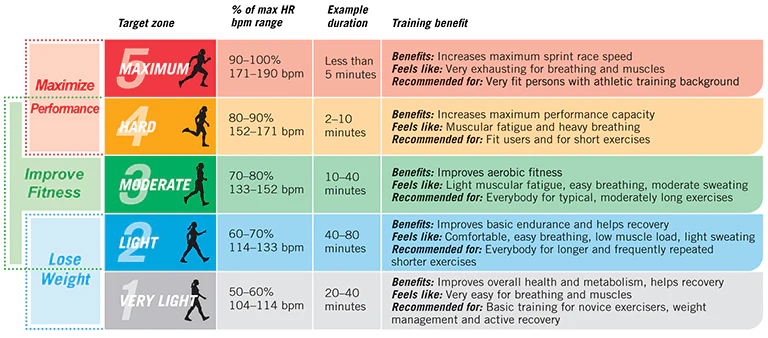“Discover how heart rate training improves running performance, prevents overtraining, and optimizes recovery. Expert tips to master your zones and run smarter.”
What Is Heart Rate Training?
Heart rate training focuses on exercising within specific heart rate zones to strengthen your aerobic system while minimizing stress on your muscles and joints. Unlike the “no pain, no gain” mindset, this method prioritizes sustainable progress over intensity.
“It’s a different way to succeed at running,” says personal trainer Erin Carr. “You don’t have to go all-out every time. Instead, you build improvements gradually.”
Thanks to affordable, accurate wearables (like chest straps and smartwatches), this approach is no longer limited to elite athletes.
“In the 1970s, only Olympians used heart rate monitors,” explains Joel French of Orangetheory Fitness. “Now, anyone can optimize their training with real-time data.”
4 Key Benefits of Heart Rate Training
Prevents Overtraining
By keeping easy/recovery runs in lower zones, you avoid pushing too hard, reducing fatigue and speeding up recovery.
Accurate Effort Tracking
Hit precise intensity levels during workouts like:
Interval sessions (high-intensity bursts)
Tempo runs (“comfortably hard” efforts)
Manages External Factors
Adjust for heat, humidity, or altitude, which spike heart rate. Training zones help you moderate effort despite conditions.
Long-Term Progress
Consistency in lower zones builds aerobic efficiency. Over time, you’ll run faster at the same heart rate—no burnout required.
Why it works?
Science-Backed: Targets your body’s energy systems for balanced development.
Personalized: Zones adapt to your fitness level, not arbitrary pace goals.
Recovery-Friendly: Lets your body rebuild stronger between hard efforts.
“The results aren’t instant,” says Carr. “But stick with slower miles, and you’ll see dramatic gains.”
Simple analogy: Easy runs = building a strong foundation. Intervals = adding turbo boosts!
How to Find Your Heart Rate Training Zones
Interval Training Pacing: How Fast ShoFinding your zones starts with estimating your maximum heart rate (MHR). While age-based formulas are popular, field tests deliver greater accuracy. Here’s how to do both:
Option 1: Age-Based Formulas
- Classic Rule: 220 – Your Age (e.g., 40 years old = 180 MHR).
- More Accurate Equations:
- Gelish Formula: 207 – (0.7 x Age)
- Tanaka Method: 208 – (0.7 x Age)
But beware:
“Age alone ignores fitness, genetics, and sex,” warns Joel French. “Dehydration, heat, or altitude can skew results by 20%.”
Option 2: Field Tests (No Lab Required)
A. Track Test:
- Warm up with 1-2 easy miles.
- Run 1 mile at tempo pace (comfortably hard).
- Gradually speed up over 400m, then sprint the final 400m all-out.
- Your highest recorded heart rate ≈ MHR.
B. 5K Test:
Run 5K at your fastest sustainable pace.
Sprint the final 1-2 minutes.
Peak heart rate ≈ MHR.
Calculating Your Zones
Once you have your MHR, multiply it by these percentages:
| Zone | % of MHR | Effort Level | Purpose |
|---|---|---|---|
| 1 | 60-70% | Easy, conversational | Warm-ups, recovery runs |
| 2 | 70-80% | Relaxed, sustainable | Base endurance building |
| 3 | 81-93% | Comfortably hard, broken speech | Tempo runs, stamina gains |
| 4 | 94-100% | Max effort, few words | 5K races, high-intensity intervals |
Example: If your MHR is 180, Zone 2 = 126–144 BPM.
Building a Heart Rate Training Plan
Apply the same structure as pace/distance plans, but with time-based sessions that adjust to your body’s signals:
- Base Phase (4-6 weeks):
- Focus on Zone 2 (70-80% MHR) for 80% of runs.
- Improves aerobic efficiency without burnout.
- Speed Phase (3-4 weeks):
- Add Zone 3-4 intervals (e.g., 4x800m at 85-93% MHR).
- Enhances lactate threshold and race pace.
- Recovery:
- Use Zone 1 for cooldowns and easy days.
“Heart rate plans adapt to hills, heat, and fitness changes,” says coach Tom Wainwright. “Perfect for hilly terrain or unpredictable conditions.”
Why It Works:
- No More Overtraining: Zones keep easy days truly easy.
- Hills? No Problem: Effort auto-adjusts for incline.
- Track Progress: Over time, you’ll run faster in the same zone.
Final Word:
“Heart rate training isn’t instant,” says French. “But stick with it, and your body will reward you.”

